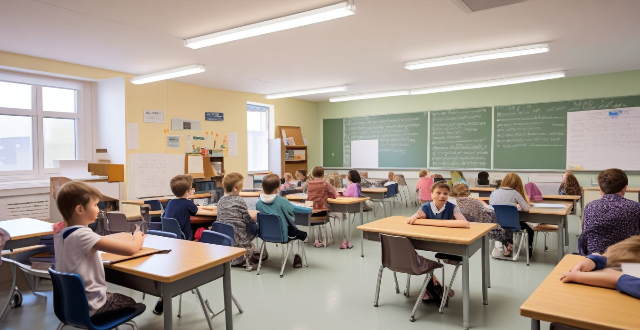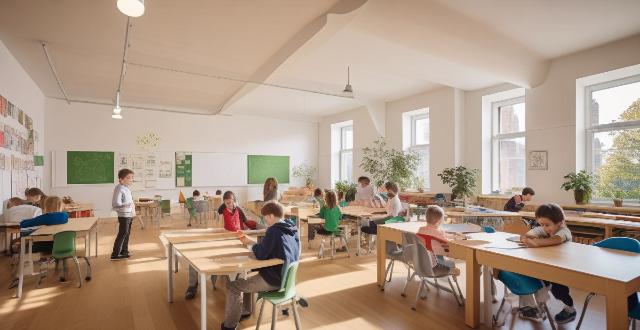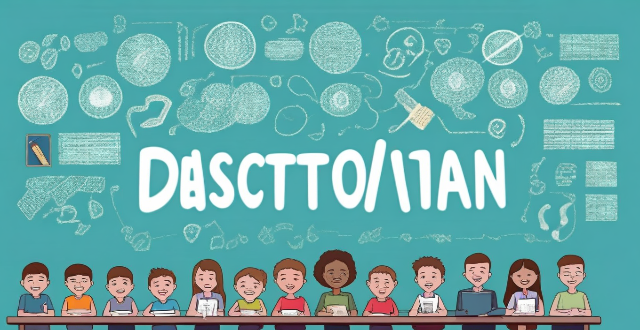Classroom Infectious

Can social distancing be implemented in schools and universities effectively ?
Social distancing is crucial to prevent the spread of infectious diseases, but implementing it in educational institutions like schools and universities can be challenging. Challenges include limited classroom space, managing student interaction outside of the classroom, and ensuring staff training and compliance. Effective strategies for implementing social distancing in these environments include classroom redesign, virtual learning options, signage and reminders, and monitoring and enforcement. By prioritizing health and safety, educational institutions can contribute to controlling the spread of infectious diseases while continuing to provide quality education.

Are there any alternative methods for preventing infectious diseases besides vaccination ?
Besides vaccination, there are several alternative methods that can help prevent the spread of infectious diseases, including hand hygiene, wearing personal protective equipment (PPE), following respiratory etiquette, and maintaining safe food practices. These measures can reduce the risk of infection and contribute to controlling the spread of infectious diseases.

Can remote education platforms replace traditional classroom learning ?
The text discusses the pros and cons of remote education platforms and concludes that they cannot fully replace traditional classroom learning due to lack of social interaction, difficulty with self-motivation, and limited hands-on experience. However, a combination of both methods may provide a well-rounded education.

Can vaccines be used to treat cancer or other non-infectious diseases ?
Vaccines are traditionally used to prevent infectious diseases by stimulating the immune system to recognize and attack specific pathogens. The possibility of using vaccines for the treatment of cancer or other non-infectious diseases is being explored, with a focus on modulating the immune response rather than stimulating it. Cancer vaccines, including preventive and therapeutic types, aim to stimulate the immune system to recognize and destroy tumor cells. For autoimmune diseases, researchers are exploring ways to use vaccines to dampen overactive immune responses or retrain the immune system. Vaccines are also being investigated for their potential in treating other chronic diseases such as Alzheimer's and heart disease. While promising, the application of vaccines in treating non-infectious diseases faces significant challenges, including identifying unique targets and balancing immune responses. Advancements in immunology and vaccine technology offer hope for new treatments that could benefit millions worldwide.

How can artificial intelligence be integrated into classroom teaching ?
Artificial intelligence (AI) can revolutionize classroom teaching by enhancing student engagement, personalizing learning experiences, and improving educational outcomes. Adaptive learning systems create personalized learning pathways and provide real-time feedback, while intelligent tutoring systems offer individualized coaching and progress tracking. Automated grading and assessment streamline the evaluation process, virtual learning assistants provide round-the-clock support, and data analytics tools inform instructional decisions. AI-powered group projects and peer feedback mechanisms facilitate collaborative learning environments. Integrating AI into classroom teaching has the potential to transform education by creating more engaging, personalized, and efficient learning experiences for all students.

What are some benefits of using online learning resources compared to traditional classroom learning ?
Online learning resources offer advantages over traditional classroom learning, including flexibility and convenience, cost savings, personalized learning experiences, exposure to diverse cultures, and development of technology skills.

How can teacher training address cultural diversity in the classroom ?
In today's globalized world, cultural diversity is an increasingly important aspect of modern classrooms. Teacher training can play a crucial role in addressing this diversity by incorporating it into curriculum design, adapting teaching methods, providing professional development opportunities, and implementing fair assessment practices. By doing so, teachers can create inclusive classrooms where all students feel valued and supported, promoting equity and enhancing learning outcomes.

What are the benefits of using flipped classroom models as an innovative teaching strategy ?
The flipped classroom model is an innovative teaching strategy that reverses the traditional learning environment by delivering instructional content outside the classroom and using class time for interactive learning activities. This approach offers several benefits, including enhanced student engagement, improved student performance, optimized classroom time, increased teacher efficiency, promotion of lifelong learning skills, cultivation of a collaborative environment, support for differentiated instruction, encouragement of parental involvement, and flexibility for teacher innovation. Overall, the flipped classroom model empowers both students and teachers to make the most out of their educational experience by leveraging technology, fostering engagement, and promoting a culture of collaboration and lifelong learning.

What are some innovative approaches to incorporating physical activity into daily classroom routines ?
Incorporating physical activity into daily classroom routines is essential for student development. Brain breaks, movement stations, active learning games, outdoor experiences, and mindful moments are effective ways to promote physical health, cognitive abilities, social skills, and emotional well-being. Examples include stretching exercises, dance parties, yoga poses, math hoops, word cones, chair yoga, scavenger hunts, Jeopardy! relay races, spelling jump rope, nature walks, field trips, outdoor classrooms, breathing exercises, body scan meditations, and gratitude journaling.

How do you create an inclusive classroom environment for students with diverse special education needs ?
Creating an inclusive classroom for students with diverse special education needs is essential. Strategies include differentiated instruction, Universal Design for Learning (UDL), collaborative learning, positive classroom culture, and professional development. These approaches ensure equal opportunities for all students to learn and thrive.

How can parents and teachers work together to address behavioral issues in the classroom ?
This text discusses the importance of collaboration between parents and teachers in addressing behavioral issues in the classroom. It emphasizes the impact of behavior on a student's academic performance, social interactions, and overall well-being, and suggests strategies for effective communication, positive reinforcement, clear expectations, differentiated interventions, and home-school collaboration. The roles and responsibilities of teachers, parents, and students are also outlined, along with challenges and solutions to overcome communication barriers, deal with resistant parties, and address complex behavioral issues. Case studies and examples are provided to illustrate successful interventions and common pitfalls, emphasizing the importance of continuous evaluation and improvement. The conclusion recaps key points and calls for active participation and ongoing support from both parents and teachers to effectively address behavioral issues in the classroom.

What are the key challenges facing global health security today ?
Global health security faces several key challenges, including emerging infectious diseases, antimicrobial resistance, weak health systems, political instability and conflict, and social determinants of health. These challenges threaten the well-being of people worldwide and require collective efforts to prevent, detect, and respond to infectious diseases that threaten human health.

Can global warming cause an increase in infectious diseases ?
Global warming can lead to an increase in infectious diseases through changes in vector habitats, host populations, and human behavior. To mitigate this impact, it is essential to reduce greenhouse gas emissions and adapt to the changing climate by implementing measures such as improving sanitation systems, vector control programs, and public health education.

How does climate change contribute to the spread of infectious diseases ?
Climate change contributes to the spread of infectious diseases by increasing temperature and humidity, altering vector habitats, causing extreme weather events, and promoting urbanization and deforestation. These factors create favorable conditions for pathogens and disease vectors, disrupt sanitation systems, increase human-wildlife contact, and facilitate rapid disease spread among humans. Addressing these issues requires a comprehensive approach that includes mitigating climate change and implementing effective public health strategies.

What is the process of vaccine allocation ?
Vaccine allocation is a crucial step in the fight against infectious diseases, such as COVID-19. It involves distributing vaccines to those who need them most, ensuring equitable access and maximizing public health benefits. The process includes determining priorities, identifying supply sources, allocating doses, distributing vaccines, and administration and tracking. By following these steps, we can ensure that vaccines are distributed equitably and effectively, helping to control the spread of infectious diseases and protect public health.

How can educational psychology help in classroom management ?
Educational psychology helps in classroom management by providing insights into student behavior, motivation, learning styles, and emotional needs. By understanding these factors, teachers can create effective strategies for managing challenging behaviors, promoting student motivation, tailoring teaching styles to different learning styles, enhancing student-teacher relationships, and addressing emotional needs. This leads to a positive and effective learning environment for all students.

Are there specific PPE recommendations for healthcare workers dealing with infectious diseases ?
The text is a set of recommendations for personal protective equipment (PPE) that healthcare workers dealing with infectious diseases should use. The recommendations include hand hygiene, respiratory protection, eye protection, body protection, footwear protection, gloves, and head protection. It emphasizes the importance of using the right PPE to minimize the risk of infection transmission and ensure the safety of healthcare workers.

What measures can be taken to prevent the spread of infectious diseases across borders ?
The text discusses measures to prevent the spread of infectious diseases across borders, including surveillance and early warning systems, travel restrictions and border controls, vaccination programs, public health infrastructure and preparedness, collaboration and information sharing, and education and public awareness. The Global Health Security Agenda (GHSA) promotes robust surveillance systems for early detection of outbreaks, while the International Health Regulations (IHR) require countries to develop core public health capacities. Travel restrictions such as entry/exit screening and quarantine policies can help prevent introduction of diseases into new regions. Vaccination programs, including routine immunization and vaccination requirements for travelers, reduce the risk of disease spread. Strong public health infrastructure and emergency response plans are crucial for containing outbreaks. Collaboration and information sharing through global health security initiatives and open access to data enable quicker identification of patterns and trends. Education and public awareness campaigns can reduce transmission rates and discourage travel to high-risk areas. By implementing these measures, countries can work together to protect public health globally.

How do biosafety policies evolve in response to emerging infectious diseases and pandemics ?
Biosafety policies are evolving in response to emerging infectious diseases and pandemics. The evolution is driven by scientific advancements, global health initiatives, and lessons from past outbreaks. Key factors driving this evolution include: - Scientific advancements such as research and development and genomic sequencing. - Global health initiatives like international collaboration and surveillance systems. - Lessons learned from past outbreaks, leading to review and revision of policies and the adoption of best practices. Examples of evolved biosafety policies include: - Laboratory biosafety with clear classification systems (BSL) and standard operating procedures (SOPs). - Public health measures such as infection prevention and control (IPC) and vaccination programs. - Travel restrictions and quarantine measures like entry screening and quarantine regulations. - International regulations and agreements, including the Biological Weapons Convention (BWC) and the Global Health Security Agenda (GHSA). The continuous evolution of biosafety policies is crucial for managing risks associated with biological agents and protecting public health.

What measures should be taken to prevent the spread of infectious diseases in a laboratory setting ?
In a laboratory setting, it is crucial to take measures to prevent the spread of infectious diseases. This includes wearing personal protective equipment (PPE), practicing proper hand hygiene, using biosafety cabinets for handling pathogens, and properly disposing of biohazardous waste. Regular cleaning and disinfection of surfaces and equipment is also essential, as well as following specific protocols for procedures like centrifugation and pipetting. By implementing these measures, the risk of infection can be significantly reduced.

What is the connection between educational psychology and cultural diversity in the classroom ?
The text discusses the importance of integrating educational psychology and cultural diversity in classroom settings to enhance learning experiences, social skills, and academic achievement. It highlights the benefits of cultural diversity in education, including enhanced learning experiences, improved social skills, and increased academic success. The role of educational psychology is also emphasized, as it provides insights into how cultural diversity affects student learning and development. Key concepts related to cultural diversity in educational psychology include cognitive development, motivation, social interaction, and assessment. Strategies for integrating cultural diversity into educational psychology practices are also discussed, such as culturally responsive teaching, inclusive curriculum design, collaborative learning, and professional development opportunities. Overall, the text underscores the significance of addressing cultural diversity in the classroom through educational psychology principles and practices.

How can we ensure equitable distribution of vaccines and treatments for infectious diseases globally ?
The text discusses strategies to ensure equitable distribution of vaccines and treatments for infectious diseases globally. It suggests increasing production capacity through investing in research and development, expanding manufacturing capabilities, improving financing mechanisms by providing financial support to low-income countries and encouraging private sector participation, strengthening infrastructure and logistics through enhancing cold chain systems and developing distribution networks, promoting political will and global cooperation through advocating for international agreements and addressing intellectual property rights issues.

What is educational psychology ?
Educational psychology is a subfield of psychology that focuses on the learning process and its influencing factors. It aims to understand students' learning, thinking, and development over time, as well as how teachers can support their educational needs. Key concepts include learning theories, cognitive development, motivation, classroom management, and assessment and evaluation. Applications of educational psychology include curriculum design, special education, counseling and mental health services, teacher professional development, and research. By applying its principles, educators can create effective teaching strategies, foster positive classroom environments, and improve student outcomes.

What strategies can teachers use to accommodate students with special education needs in the classroom ?
Strategies for Accommodating Students with Special Education Needs in the Classroom As an educator, it is essential to create an inclusive learning environment that meets the needs of all students, including those with special education needs. In this article, we will explore some effective strategies that teachers can use to accommodate students with special education needs in the classroom. 1\. Differentiated Instruction Differentiated instruction is a teaching approach that tailors instruction to meet individual student needs. This strategy involves modifying curriculum, instruction, and assessment to address diverse learning styles, abilities, and interests. Here are some ways to implement differentiated instruction: * **Varying the complexity of tasks**: Assign tasks of varying difficulty levels based on students' abilities and progress. * **Providing multiple means of representation**: Use visual aids, manipulatives, or technology to help students understand complex concepts. * **Offering choices in assignments**: Allow students to choose from different assignments or projects that align with their interests and strengths. 2\. Collaborative Learning Collaborative learning encourages students to work together to achieve common goals. This approach can benefit students with special education needs by providing opportunities for social interaction and peer support. Some collaborative learning strategies include: * **Group work**: Assign students to groups based on their skills and interests, ensuring each member has a role to play. * **Partner reading**: Have students read aloud with a partner, taking turns summarizing what they have read. * **Peer tutoring**: Match students with stronger academic skills with those who need additional support, allowing them to learn from each other. 3\. Assistive Technology Assistive technology refers to tools and devices designed to help individuals with disabilities perform tasks more easily. Incorporating assistive technology into the classroom can greatly benefit students with special education needs. Some examples of assistive technology include: * **Speech recognition software**: Helps students with physical limitations or dyslexia to dictate their thoughts and ideas. * **Audiobooks**: Provides auditory input for students who struggle with reading comprehension. * **Graphic organizers**: Visual tools that help students organize information and ideas, particularly useful for students with learning disabilities or ADHD. 4\. Clear and Consistent Routines Establishing clear and consistent routines can help reduce anxiety and increase predictability for students with special education needs. Some ways to implement routines include: * **Schedule boards**: Display daily schedules visually to help students understand what to expect throughout the day. * **Transitional cues**: Use verbal or visual cues to signal when it's time to switch activities or move to a different location. * **Predictable lesson structures**: Follow a consistent format for lessons, such as starting with a warm-up activity, followed by direct instruction, independent practice, and wrap-up discussions. 5\. Positive Behavioral Interventions and Supports (PBIS) PBIS is a framework designed to create positive school cultures by promoting appropriate behavior and supporting students in need of behavioral interventions. Some PBIS strategies include: * **Reinforcement systems**: Reward positive behaviors with tangible incentives or praise. * **Social skills training**: Teach students how to interact appropriately with peers and adults through role-playing and modeling. * **Behavior contracts**: Work with individual students to develop agreements outlining expected behaviors and consequences. 6\. Parental Involvement and Communication Maintaining open communication with parents is crucial for supporting students with special education needs. Some ways to involve parents include: * **Regular conferences**: Schedule meetings with parents to discuss their child's progress and address any concerns. * **Homework hotlines**: Provide a phone number or email address where parents can reach out for assistance with homework assignments. * **Family engagement activities**: Plan events that allow families to participate in school activities, fostering partnerships between home and school.

What are some common challenges faced by educators when implementing data analytics in their classrooms ?
Educators face several challenges when implementing data analytics in their classrooms, including a lack of training and support, limited access to technology and data, time constraints, resistance to change, and privacy and ethics concerns. These challenges can make it difficult for teachers to effectively integrate data analytics into their teaching practices, potentially limiting the benefits that data-driven strategies can offer for improving student outcomes.

How do virtual classrooms compare to traditional classrooms in terms of learning effectiveness ?
The text presents a comparative analysis of virtual classrooms and traditional classrooms in terms of learning effectiveness. The comparison is structured around several aspects: 1. **Learning Environment**: Traditional classrooms offer physical interaction but limited resources, while virtual classrooms provide flexibility and access to diverse resources. 2. **Teaching Methods**: Direct instruction and group work are emphasized in traditional settings, whereas interactive tools and personalized learning are characteristic of virtual environments. 3. **Student Participation**: Active participation and social dynamics are key in traditional classrooms, while virtual settings allow for asynchronous participation and cater to introverted students. 4. **Assessment and Feedback**: Immediate feedback and formative assessment are strengths of traditional classrooms, while automated feedback and summative assessment are advantages of virtual classrooms. 5. **Conclusion**: The choice between traditional and virtual classrooms depends on various factors, and an ideal approach could be a blended method that combines the best elements of both.

How do women's health and education projects address global disparities ?
Women's health and education are crucial for global development, affecting communities' well-being. Women's health projects ensure access to quality healthcare services, including prenatal care and family planning. Education initiatives promote gender equality by increasing girls' enrollment rates and eliminating classroom biases. Economic empowerment projects provide job training and microfinance loans to women entrepreneurs. These efforts create a more equitable world where everyone can thrive.

What are the current global health challenges ?
The world is facing a multitude of health challenges that require immediate attention and action, including infectious diseases, non-communicable diseases, mental health issues, and environmental health hazards. Infectious diseases such as COVID-19, HIV/AIDS, tuberculosis, and malaria continue to be a major threat to global health. Non-communicable diseases like cardiovascular diseases, cancer, diabetes, and chronic respiratory diseases are becoming increasingly prevalent globally. Mental health disorders, including depression, anxiety disorders, and substance abuse, are a growing concern worldwide. Environmental factors such as air pollution, water pollution, climate change, and natural disasters also pose significant risks to human health.

What role does public health play in the implementation of biosafety policies ?
Public health is crucial for implementing biosafety policies, which aim to contain and manage biological agents that may pose a risk to human health, animal health, or the environment. Public health professionals play key roles in surveillance and disease detection, risk assessment and management, laboratory biosafety, vaccination programs, public education and awareness, policy development and implementation, emergency response, and international collaboration. By monitoring disease trends, assessing risks, maintaining laboratory safety, promoting vaccination, educating the public, developing policies, responding to emergencies, and collaborating internationally, public health professionals help protect individuals and communities from biological hazards.

Can extracurricular activities improve academic performance ?
Extracurricular activities can improve academic performance by developing time management skills, increasing motivation and engagement, enhancing social skills and networking, and providing stress relief and mental health benefits.